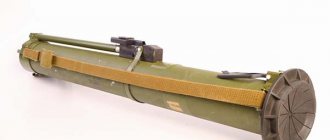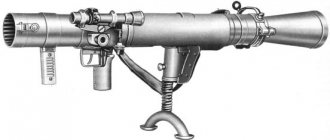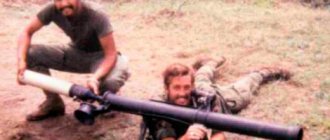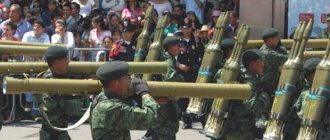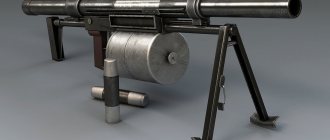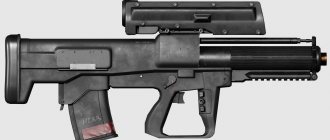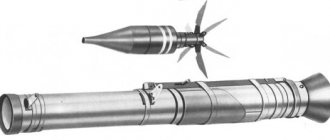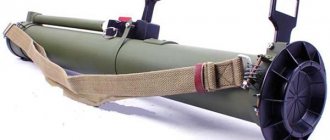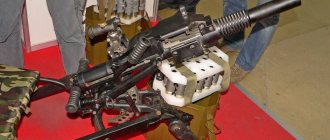Design description[edit]
The grenade launcher has a revolving design and consists of a pipe with a handle, a drum block, a body with an axle and a power rod, a trigger mechanism with a pistol grip and a folding butt. To install additional equipment (day and night sights) there are Picatinny rails around the barrel. The grenade launcher itself is made of stamped steel, the grenade drum is made of aluminum alloy, and the handles and fittings are plastic.
The automatic supply of ammunition is based on a ratcheting mechanism for rotating the drum, which is released under the influence of the pressure of the powder gases removed from the barrel. Despite the complication of the design of the weapon, this solution makes it possible, in case of a misfire, to try to fire the same grenade again.
Equipped with a standard collimator sight.
The grenade launcher is made of stamped steel, the drum is made of aluminum alloy, the handles and fittings are plastic. Sights - metal; Optical and night sights can be installed. The effective fire range is about 400 meters.
Revolver grenade launcher
The appearance of the MGL revolver grenade launcher in South Africa in the 80s gave a new impetus to the development of a previously forgotten type of weapon. Somewhat later, Russia appeared with its own original version of the six-shot revolver-grenade launcher - RG-6.
African footprint
The first prototype of the MGL (Multi-shot Grenade Launcher) multi-shot grenade launcher was a 37 mm twelve-shot prototype for the use of non-lethal ammunition. Soon, the founder of the South African company Milkor Ltd, Andris Pick, converted the weapon to accept 40x46 mm ammunition and offered the local military a six-round grenade launcher. The weapon has successfully passed tests and has been used in the South African armed forces since 1983 under the symbol Y2. From that time on, the creeping expansion of revolver grenade launchers began throughout the world.
40 mm South African MGL grenade launcher milkor.com
Around the same time, analogues of such weapons appeared in the United States. Externally, the MM-1 of the American company Hawk Engineering looked the same as the 37-mm South African prototype, which is not at all accidental. It is difficult to say who can be called pioneers in this field, since both of them took their cue from Charles Manville’s automatic revolving gun, patented back in 1937 and shown in the American film “Dogs of War” in 1980. However, it was the South Africans who were able to create a model from a bulky multi-charged product that was acceptable in size and characteristics.
Thanks to the revolver system, such a weapon has become a popular police weapon that can use low-power, non-lethal ammunition. For revolving grenade launchers, there are not only 40 mm ammunition, but also special 37/38 mm ammunition. In this version, such a weapon becomes more of a large-caliber smoothbore revolving gun rather than a grenade launcher. For example, in Poland, a 1986 model grenade launcher (RGA-86) appeared in service with the Ministry of Internal Affairs, which was practically a copy of the above-mentioned systems, only chambered for 26-mm signal and special cartridges.
37/38 mm grenade launchers: American MM-1 (top) and South African MGL (bottom) gunbroker.com
As a result, already in the 2000s, a copy of the MGL produced by the American company Milkor USA under the symbol M32 began to undergo trial operation in units of the US Marine Corps. The M32A1 version, modified based on the test results, entered service with the American Marines. There is also information about the use of similar weapons by US Special Operations Forces (USSOCOM). At the same time, revolver grenade launchers have not been able to displace under-barrel grenade launchers and are used to a limited extent by special forces of the police and army in various countries of the world.
M-32 grenade launcher in the hands of an American Marine marines.mil
Today, a whole range of 40-mm revolver grenade launchers are produced in the world: Vietnamese SPL40L, Chinese JA1 or LG4, Bulgarian MSGL, Polish RGP-40, Serbian (or licensed Azerbaijani) M11, Croatian RGB-6. They also produce their own versions in some countries in Asia and Latin America. All of the listed models are, to one degree or another, copies or legal localizations of the South African system, many of them have been modified to meet the requirements of local law enforcement agencies. The geography of production and use of the MGL family is very extensive, numbering dozens of countries and several continents.
1/5
Heading1
Heading2
Heading3
Heading4
Heading5
40-mm Vietnamese grenade launcher SPL40L vietnamdefence.vdi.org.vn
40mm Chinese JA1 grenade launcher cjaie.com
40-mm Croatian grenade launcher RGB-6 aalan.hr
40-mm Azerbaijani M11 grenade launcher mdi.gov.az
40-mm Polish grenade launcher RGP-40 zmt.tarnow.pl
At the dawn of hand grenade launchers
Work on the first Soviet automatic grenade launchers began back in the 30s at OKB-16 under the leadership of Ya.G. Taubina. However, it was a heavy infantry weapon mounted on a machine. A project for a hand-held version of such a 25 mm GAN grenade launcher appeared at the same OKB-16 in the mid-30s. Unfortunately, the design details of the automatic pistol-grenade launcher are still unknown, as is the automation scheme proposed by the authors of the invention, Ya.G. Taubin and A.E. Nudelman.
One of the first attempts in the USSR to practically introduce a revolving design into the design of a grenade launcher was attempted by Captain M.M. Kulakov, who proposed his original design of a five-shot model in 1943. The Main Artillery Directorate (GAU) of the Red Army took the inventor’s idea very seriously and instructed specialists from the design department of the Small Arms Research Site (NIPSVO) to debug a grenade launcher designed by Kulakov in November of the same year.
44.15 mm Kulakov grenade launcher, 1944 kalashnikov.ru
In December 1943, the author of the invention was sent with a sample of a grenade launcher to plant No. 614 in Saratov, where new parts were made for the weapon. A 44.15 mm grenade launcher barrel and a five-seat drum barrel block were mounted in place of the rifle barrel of the 1891/30 model. The automatic grenade launcher operated due to the powder gases of the expelling blank rifle cartridge, which threw a projectile (grenade). Field tests in April 1944 issued a categorical verdict - “revision is impractical”
. The design turned out to be heavy and cumbersome, the automation did not work, the grenades were simple metal blanks. In addition, the tactical niche of such weapons in the Red Army was firmly held by mortars.
Much later, in 1969, an attempt to increase the firepower of an infantryman was proposed at the design bureau of the Izhevsk Machine-Building Plant. The idea was to design a weapon similar to the American M-79, combining the properties of a grenade launcher and a submachine gun (machine gun). However, military experts rejected such a combined weapon even at the stage of theoretical justification, giving preference to the development of an under-barrel grenade launcher for the machine gun.
Domestic "Gnome"
The history of the appearance of the first serial Russian revolver grenade launcher in the early 90s has already acquired various legends. For example, the impetus for the development of such a grenade launcher was allegedly the same South African MGL, seized in 1993 in the wake of events at the White House, and that a new model was created in less than two weeks. At the same time, the undoubted facts remain the influence of the design of the Western analogue on Tula engineers and the shortest possible time frame for completing experimental work in 1993.
The first experimental work on the RG-6 grenade launcher at the Tula Central Design Research Bureau of Sports and Hunting Weapons (TsKIB SOO) under the leadership of V.I. Telesha was planned back in 1992. After an unexpected surge of interest on the part of security forces, the process of developing a grenade launcher intensified significantly, and already at the beginning of 1994, experimental products were tested by the Ministry of Internal Affairs of the Russian Federation.
40-mm grenade launcher 6G30 kbptula.ru
Around the same time, the Main Rocket and Artillery Directorate (GRAU) of the Russian Ministry of Defense showed interest in a non-standard grenade launcher. At the end of 1994, development work (R&D) for the Gnome opened, and the RG-6 grenade launcher was given the index 6G30.
The Russian large-caliber "revolver" had more differences than similarities with its Western "relative". The only things that were common were the revolver automatic weapon design and appearance. The Russian grenade launcher had a rotating block of rifled barrels instead of charging chambers. The difference in approaches is largely due to the ammunition used. The NATO standard 40mm shot had a 46mm long case, while the Soviet VOG-25 was designed with a flyaway case. As a result, the RG-6 was loaded from the muzzle of the barrel block, while the MGL was loaded from the breech, with the additional mandatory condition of extracting spent cartridges.
Russian special forces soldier armed with a 6G30 grenade launcher K. Lazarev
As a result, the difference between the two systems affected the rate of fire of the grenade launchers. For the Russian one it was only 12 rounds per minute, and for the Western ones - from 18 to 24. At the same time, the reloading procedure causes difficulties in both cases, and for the RG-6, after equipping with new shots, the spring of the receiver unit must be cocked. The main disadvantage of revolver weapons is the inability to use ammunition longer than the charging chamber (barrel for RG-6). Also, both systems have large transverse dimensions and inertia of the ammunition unit. In the case of the RG-6, due to the short barrel length, low accuracy and shooting accuracy are added.
The 6G30 grenade launcher was adopted by the Ministry of Internal Affairs in 1996, and by the Ministry of Defense in 2002. And while the “Gnome” managed to fight in the Caucasus among the police and became a standard non-lethal special weapon, the military was unable to fully appreciate the new grenade launcher. There are no data on purchases for the military or use of the 6G30 in army units. Attempts have been made to offer a grenade launcher with special high-explosive ammunition for the needs of the Russian FSO. The complex is also used by units of the Federal Penitentiary Service (FSIN).
Alternatives
Despite certain disadvantages of revolver weapons, such systems also have their advantages. A grenade launcher can fire a salvo of six grenades within three seconds, while combining their purposes. In comparison with store-bought analogues (for example, GM-94), the rate of fire of revolvers turns out to be approximately equivalent. However, a more universal option could be hand grenade launchers with a drum-type under-barrel magazine. Such weapons are widely used in the Chinese army (with magazines with a capacity of up to 15 rounds), but in Russia things have not gone further than the experimental 30-mm grenade launcher TKB-0249.
40-mm Bulgarian grenade launcher "Avalanche" arsenal-bg.net
The Bulgarian produced its own version of the Avalanche revolver grenade launcher for VOG-25 type shots. Due to the absence of a false barrel, such a grenade launcher turned out to be almost half as long as its NATO standard counterparts. The modern version of the MSGL-M looks like the Russian 6G30, only with a very short false barrel. However, it can compete with MGL only in countries of the former socialist camp, where there are still reserves of VOG-25, and production of their own versions of this type of ammunition has been established.
Already in the 2000s, the Tula TsKIB SOO offered the TKB-0257 under-barrel revolver grenade launcher as a kit for the 12.7 mm SHAK-12 assault complex. The mini-revolver fires 25mm grenades and has three barrels. The mass of the complex increased by 0.7 kg, but at the same time added firepower to the large-caliber ASh-12 assault rifle. However, the status of this experimental development remains unclear.
25-mm under-barrel revolver grenade launcher TKB-0257 as part of the ShAK-12 i-korotchenko.livejournal.com
Technical characteristics of 40-mm grenade launchers
| M.G.L. | M32A1 | M11 | MSGL | RGP-40 | MSGL-M | 6G30 | |
| A country | South Africa | USA | Serbia | Bulgaria | Poland | Bulgaria | Russia |
| Shot | 40×46 | 40×46 | 40×46 | 40×46 | 40×46 | VOG-25 | VOG-25 |
| Length, mm | 768 / 566 | 739 / 648 | 800 / 725 | 764 / 530 | 850 | 525 / 388 | 690 / 520 |
| Barrel length, mm | 310 | 203 | 300 | 230 | 250 | n/a | 120 |
| Weight, kg | 5,3 | 6,63 | 5,9 | 6,53 | 6,3 | 7,0 | 6,2 |
| Sighting range, m | 375 | 375 | 400 | 400 | 400 | 400 | 380 |
| Capacity, shots | 6 | 6 | 6 | 6 | 6 | 6 | 6 |
Sources and literature:
- MGL. 40 mm multi-shot grenade launcher. Operator's instructions manual. OIM 453 M
- 40 mm hand-held anti-personnel grenade launcher. Operating manual 6G30 RE
- Yu. Ponomarev. The grandfather of revolver grenade launchers. Kalashnikov, No. 8, 2012
- L. Semenov. Revolver-type grenade launcher. Weapons, No. 1, 1997
Ammunition nomenclature[edit]
Can be used with all low velocity (40x46mm LV) NATO ammunition, for example:
- M406
- high explosive shot (
HE
); - M433
- cumulative round (
HEDP
) for hitting lightly armored targets; - M576
- shot with large shot (20 spherical buckshot); - M670
- smoke shot; - M585
- auxiliary ammunition for lighting and signaling; - M651
- non-lethal tear gas shot; - XM1060
- thermobaric ammunition for fighting the enemy in shelters and fortifications; - HUNTIR
(English:
H
igh-altitude
U
nit
N
avigated Tactical
Imaging
Round
) - a shot for throwing up an infrared video camera, which, when descending by parachute, allows you to inspect the surroundings
.
40mm grenade launcher Milkor MGL (South Africa)
Milkor MGL Mk.1S grenade launcher
Milkor MGL Mk.1L / MGL-140 grenade launcher with extended drum
Milkor SuperSix MRGL grenade launcher
Milkor MGL-140 grenade launcher in action.
| Mk-1S MGL | Mk-1L MGL | SuperSix MRGL | |
| Caliber | 40×46 LV | 40×46 LV | 40x46 LV and 40x51 MV |
| Type | revolver | ||
| length | 765 / 685 mm | 795 / 715 mm | 805 / 725 mm |
| Weight | 5.92 kg | 6.45 kg | 6.5 kg |
| Capacity | 6 shots | ||
| Maximum effective range | 400 m | 400 m | 800 m (MV grenades) |
The development of a new multi-shot grenade launcher designed for low-velocity 40mm grenades (40x46 LV = Low Velocity) was started in South Africa around 1980, based on the successful experience of operating American M79 single-shot grenade launchers. In 1981, the Milkor company presented the first prototype of the YMGL grenade launcher, and already in 1983 its mass production began under the Milkor MGL (Multi-shot Grenade Launcher) symbol. In 1996, a slightly improved modification of the Milkor MGL Mk.1 appeared. In 2004, two new modifications appeared - Milkor MGL Mk.1S and Milkor MGL Mk.1L (also designated MGL-140). These modifications are distinguished by a more durable design and the presence of optional Picatinny rails on the barrel, designed for mounting additional sights and other accessories. In addition, the MGL Mk.1L / MGL-140 variant has an elongated drum, allowing it to load non-lethal grenades (gas, with rubber buckshot) with a longer warhead. In 2008, a version of the Milkor 40mm SuperSix Multiple Range Grenade Launcher (MRGL) was developed, designed to use both standard low-speed grenades and new grenades with an “average speed” of 40x51 MV (initial grenade speed 100-115 m/s versus 75 -78m/s for 40×46 LV grenades with a comparable warhead mass). Since such an increase in initial speed led to an increase in the recoil impulse of the weapon by almost a third, the SuperSix MRGL grenade launcher has a spring recoil damper built into the butt.
Currently, Milkor MGL grenade launchers in various versions are in service with armies and other security forces in more than fifty countries around the world. Copies of Milkor MGL grenade launchers are produced in Croatia at the RH Alan plant, in Bulgaria by the Arsenal plant, in China by the NORINCO corporation, as well as in South Africa by Rippel Effect (called Milkor Marketing until 2005) and in the USA by MilkorUSA.
The Milkor MGL grenade launcher provides high mobility and significant firepower, especially useful during close maneuver combat, including in the city. Milkor has developed a twin MGL grenade launcher system specifically for cars and light boats, providing significant firepower in a short period of time.
The Milkor MGL grenade launcher is a revolver type, six-round. The drum is loaded from the breech, after the rear part of the grenade launcher with a pistol grip is folded to the side and up. The rotation of the drum is carried out by a spring, which is manually charged during the loading process. The trigger mechanism is self-cocking and has a manual safety. A distinctive feature of the MGL grenade launcher is that the ratchet mechanism for turning the drum is released under the action of the powder gases removed from the barrel, which act on the pusher piston at the moment of firing. Although this solution complicates the design of the weapon, in case of a misfire, it allows you to try to fire the same grenade again (by simply pressing the trigger), and also to safely wait time in the event of a prolonged shot (with the misfired grenade still located opposite the barrel). The standard sight is a collimator sight, mounted on an adjustable base with a scale for entering corrections for the firing range. The buttstock folds upward, has a rubber shock-absorbing butt pad
In culture[edit]
Gaming industry[edit]
- This grenade launcher is present in the following video games: Arma II, Arma III, Blockade 3D, GTA V, Killing Floor, Max Payne 3, Operation Flashpoint: Dragon Rising, PAYDAY 2, PROTOTYPE (in both parts), Spec Ops: The Line.
- Battlefield 4 - called " M32 GL
" (as a high damage pick-up weapon). - Call of Duty: Black Ops II - called " MZG
" (multi-charge grenade launcher). - Call of Duty: Ghosts - called " MK32
". - Combat Arms - called " M32
". - Far Cry 2 - called MGL-140
is the most powerful weapon in the game. - Resident Evil 5 has twelve shots, unlike the original one.
- In the weapons simulator game “World of Guns: Gun Disassembly” you can get acquainted with the real functioning of the 3D model of the M32 MGL

